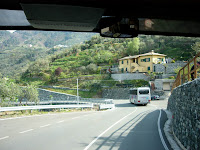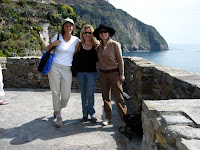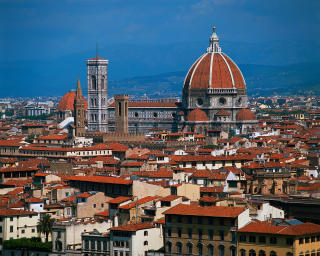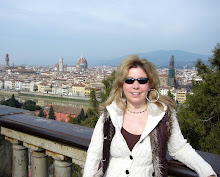
 We met at the bus station at 7:45 to take the approximately three-hour ride to Cinque Terre. Although this sounds like a long time to be on a bus, every trip through the Italian countryside makes the ride well worth it. Eventually we pulled off the highway, and instead of the ride simply being beautiful, it suddenly became thrilling as our two buses wound their way along narrow roads, often next to a sheer drop-off. Luckily our drivers knew exactly what they were doing. Turn after turn, their horns sounded loudly to warn anyone who might be driving in the other direction. We’re here! Every once in a while we encountered another vehicle, and at times it seemed impossible that our driver would find a way to get by, the roads were so narrow. But he always did, and soon we were driving downhill toward one of the Cinque Terre villages, Monterossa al Mare.
We met at the bus station at 7:45 to take the approximately three-hour ride to Cinque Terre. Although this sounds like a long time to be on a bus, every trip through the Italian countryside makes the ride well worth it. Eventually we pulled off the highway, and instead of the ride simply being beautiful, it suddenly became thrilling as our two buses wound their way along narrow roads, often next to a sheer drop-off. Luckily our drivers knew exactly what they were doing. Turn after turn, their horns sounded loudly to warn anyone who might be driving in the other direction. We’re here! Every once in a while we encountered another vehicle, and at times it seemed impossible that our driver would find a way to get by, the roads were so narrow. But he always did, and soon we were driving downhill toward one of the Cinque Terre villages, Monterossa al Mare.


 We couldn’t wait to get off the bus to feel the sea air on our faces! The water was crystal clear and brilliantly blue, the sky was filled with wispy white clouds, and the air was balmy: a day custom-made for our group!
We couldn’t wait to get off the bus to feel the sea air on our faces! The water was crystal clear and brilliantly blue, the sky was filled with wispy white clouds, and the air was balmy: a day custom-made for our group!
 After a brief orientation by the AIFS staff, during which we received a train pass (a train runs regularly among the five villages) and a pass to hike the trail from village to village, we were on our own to explore until 6 p.m., when we would all meet back in Monterossa for dinner.
After a brief orientation by the AIFS staff, during which we received a train pass (a train runs regularly among the five villages) and a pass to hike the trail from village to village, we were on our own to explore until 6 p.m., when we would all meet back in Monterossa for dinner.


 The faculty and friends/family (Bob, Janet, Toni, Coley, Jennifer, and I) decided to hike to the second village, Vernazza. But first we took in Monterossa as we passed through it on the way to the trail. Monterossa is probably the most popular destination of the five villages because not only is it the largest village (population of approximately 1,700), but it also has the largest beach. Colorful boats sit on the sand, and pastel buildings line the shores, all with a backdrop of rugged cliffs, making for such a delightful scene. Shortly we made it to the trail, Trail No. 2 (also known as the Sentiero Azzurro, or “Blue Trail”), that would take us to the next village, Vernazza.
The faculty and friends/family (Bob, Janet, Toni, Coley, Jennifer, and I) decided to hike to the second village, Vernazza. But first we took in Monterossa as we passed through it on the way to the trail. Monterossa is probably the most popular destination of the five villages because not only is it the largest village (population of approximately 1,700), but it also has the largest beach. Colorful boats sit on the sand, and pastel buildings line the shores, all with a backdrop of rugged cliffs, making for such a delightful scene. Shortly we made it to the trail, Trail No. 2 (also known as the Sentiero Azzurro, or “Blue Trail”), that would take us to the next village, Vernazza.




 We had heard that this stretch of the trail was the most challenging of all. Boy, they weren’t kidding! The trail itself is very well-built, which is good because it literally hangs off the cliffs, with sheer dropoffs to the sea below. Definitely not for the weak of heart or those with a fear of heights! And much of the trail consists of steps, most straight up. (Maybe we should have tried coming back the opposite way instead!) So we climbed and climbed, stopping several times along the way to catch our breath and to gulp some water. Oh yes, and to take pictures! This is perhaps the most scenic trail I’ve ever taken. The beauty of this coastline is beyond words.
We had heard that this stretch of the trail was the most challenging of all. Boy, they weren’t kidding! The trail itself is very well-built, which is good because it literally hangs off the cliffs, with sheer dropoffs to the sea below. Definitely not for the weak of heart or those with a fear of heights! And much of the trail consists of steps, most straight up. (Maybe we should have tried coming back the opposite way instead!) So we climbed and climbed, stopping several times along the way to catch our breath and to gulp some water. Oh yes, and to take pictures! This is perhaps the most scenic trail I’ve ever taken. The beauty of this coastline is beyond words. 




 Along the way we passed scenic overlooks, spring flowers in full bloom, lush foliage, vineyards, and, oh yes, a student or two!
Along the way we passed scenic overlooks, spring flowers in full bloom, lush foliage, vineyards, and, oh yes, a student or two! And then there was that man selling lemons for 50 cents each, and getting plenty of takers!
And then there was that man selling lemons for 50 cents each, and getting plenty of takers!


 After about an hour and a half on this beautiful yet rigorous trail, we finally spotted the next village, nestled down in a cove. Vernazza turned out to be my favorite of the five villages (yes, I went to all five!). The buildings in this town seem more vibrant than the others, and the streets are lined with cafés with bright, colorful umbrellas. The sound of music filled the air as we made our way down steep steps into the heart of the village.
After about an hour and a half on this beautiful yet rigorous trail, we finally spotted the next village, nestled down in a cove. Vernazza turned out to be my favorite of the five villages (yes, I went to all five!). The buildings in this town seem more vibrant than the others, and the streets are lined with cafés with bright, colorful umbrellas. The sound of music filled the air as we made our way down steep steps into the heart of the village.




 We were famished! Walking for almost two hours in the heat, most of it uphill, will definitely help you work up an appetite! So we headed straight for one of the cafés sitting right on the water. Under our bright orange umbrella we enjoyed pizza and pasta, and lots of water and Coca-Cola Light! A four-piece band entertained us with upbeat jazz, and we were glad when the sounds attracted the attention of three of our students, who also thoroughly enjoyed the ambience as they sat under their striped umbrella.
We were famished! Walking for almost two hours in the heat, most of it uphill, will definitely help you work up an appetite! So we headed straight for one of the cafés sitting right on the water. Under our bright orange umbrella we enjoyed pizza and pasta, and lots of water and Coca-Cola Light! A four-piece band entertained us with upbeat jazz, and we were glad when the sounds attracted the attention of three of our students, who also thoroughly enjoyed the ambience as they sat under their striped umbrella.


 After fortifying ourselves, it was time to continue on our journey. After consulting the map and considering many different possibilities, we decided to take the train to the last village, Riomaggiore. When we got onto our train, we discovered a carload of our students, also going to Riomaggiore, even bringing pizza along with them for their lunch!
After fortifying ourselves, it was time to continue on our journey. After consulting the map and considering many different possibilities, we decided to take the train to the last village, Riomaggiore. When we got onto our train, we discovered a carload of our students, also going to Riomaggiore, even bringing pizza along with them for their lunch!Riomaggiore is the easternmost of the villages, and is the only village that is accessible by car. Even so, this doesn’t make it any less charming, just not quite as charming as the other four villages. Therefore, we didn’t stay here long but headed straight for the trail to take us back to the village of Manarola. (At this point we were down to four as we lost Bob and Jennifer in Riomaggiore.)




 This stretch of the Sentiero Azzurro (Blue Trail) between Riomaggiore and Manarola is the most popular of entire trail. It’s known as Via dell’Amore (Road of Love). It’s said that this stretch got its name because it was built by hand, a real labor of love. To get to the trail, you walk beneath a gate crowned with two hearts—very appropriate! Along the trail are sets of steps leading down to the rocks below. We even spotted a few students enjoying their time relaxing on the rocks at the water’s edge.
This stretch of the Sentiero Azzurro (Blue Trail) between Riomaggiore and Manarola is the most popular of entire trail. It’s known as Via dell’Amore (Road of Love). It’s said that this stretch got its name because it was built by hand, a real labor of love. To get to the trail, you walk beneath a gate crowned with two hearts—very appropriate! Along the trail are sets of steps leading down to the rocks below. We even spotted a few students enjoying their time relaxing on the rocks at the water’s edge.

This part of the trail also contains a few tunnels, lined with windows so that walkers can continue admiring the views.
 In one tunnel we came across a railing that was lined with mementos—charms, ribbons, keys, and other items that people have left over the years as symbols of their love. Very touching!
In one tunnel we came across a railing that was lined with mementos—charms, ribbons, keys, and other items that people have left over the years as symbols of their love. Very touching!


 This part of the trail is remarkably short, and soon we reached the village of Manarola. This is probably the most industrious of the villages, primarily known for its wine and olive oil production. We were also surprised to see boats lining the streets as we walked along. However did they get these to the water? When we arrived at the cove, we got our answer: a large crane-like device is used to lower boats several feet below into the sea.
This part of the trail is remarkably short, and soon we reached the village of Manarola. This is probably the most industrious of the villages, primarily known for its wine and olive oil production. We were also surprised to see boats lining the streets as we walked along. However did they get these to the water? When we arrived at the cove, we got our answer: a large crane-like device is used to lower boats several feet below into the sea. At this point we decided to split up. Toni and Coley wanted to hike the entire trail, and Janet and I wanted to see the Cinque Terre from the water. So we boarded a ferry in Manarola that took us back to the town of Vernazza, where we had had lunch.
At this point we decided to split up. Toni and Coley wanted to hike the entire trail, and Janet and I wanted to see the Cinque Terre from the water. So we boarded a ferry in Manarola that took us back to the town of Vernazza, where we had had lunch.
 We first learned that there are no docks in Manarola. Instead, the ferry pretty much just comes straight up to the rocks and lowers a ramp onto them on which we walked into the boat. To see Cinque Terre from the water is an entirely different experience, and a quite amazing one at that. This is how you can really get the feel for how these tiny villages are perched on sheer cliffs. The fact that these villages were built centuries ago makes it even more amazing.
We first learned that there are no docks in Manarola. Instead, the ferry pretty much just comes straight up to the rocks and lowers a ramp onto them on which we walked into the boat. To see Cinque Terre from the water is an entirely different experience, and a quite amazing one at that. This is how you can really get the feel for how these tiny villages are perched on sheer cliffs. The fact that these villages were built centuries ago makes it even more amazing. The ferry took us by the village of Corniglia but was unable to stop. That’s because this village is perched high on a cliff, making docking impossible.
The ferry took us by the village of Corniglia but was unable to stop. That’s because this village is perched high on a cliff, making docking impossible.

 We then reached Vernazza. Upon disembarking, we came across two more students who were enjoying watching watching people cliff diving below the town’s fortress tower.
We then reached Vernazza. Upon disembarking, we came across two more students who were enjoying watching watching people cliff diving below the town’s fortress tower. Well, we had one more town to visit, and that was Corniglia, back the way we had just come. So Janet and I boarded a train, which took us to this village, the most remote of the five. I think this is perhaps what made this village feel the most authentic. Few tourists make it to this town because doing so requires a climb of over 300 stone steps. (We opted to take a bus up to the town, although we walked back down the steps when we left.)
Well, we had one more town to visit, and that was Corniglia, back the way we had just come. So Janet and I boarded a train, which took us to this village, the most remote of the five. I think this is perhaps what made this village feel the most authentic. Few tourists make it to this town because doing so requires a climb of over 300 stone steps. (We opted to take a bus up to the town, although we walked back down the steps when we left.)
 Once in the town, we enjoyed the spectacular views of the other four villages. We also bought some postcards and took them to a café, where we made them out over some local white wine. Also over wine we made an important decision. You
Once in the town, we enjoyed the spectacular views of the other four villages. We also bought some postcards and took them to a café, where we made them out over some local white wine. Also over wine we made an important decision. You  see, the students were going to return to Monterossa for dinner, which consisted of lasagne and chicken. Well, here we were at the sea. We could get plenty of lasagne and chicken in Florence. What we really wanted was seafood! So we called the AIFS staff to let them know that we would be having dinner on our own.
see, the students were going to return to Monterossa for dinner, which consisted of lasagne and chicken. Well, here we were at the sea. We could get plenty of lasagne and chicken in Florence. What we really wanted was seafood! So we called the AIFS staff to let them know that we would be having dinner on our own.We then boarded a train that took us back to Monterossa and found a delightful restaurant named Miky. Here, with beautiful views of the sea, Janet and I enjoyed grilled local fish and vegetables, as well as decadent desserts. In fact, Janet says that this may well be the best meal she’s had the entire trip. I agree!
 The only thing is that when the bus was ready to depart, we hadn’t been served our entrée yet. We decided that it was more important to relax and enjoy this wonderful meal, meaning that we would have to get back on our own.
The only thing is that when the bus was ready to depart, we hadn’t been served our entrée yet. We decided that it was more important to relax and enjoy this wonderful meal, meaning that we would have to get back on our own. The bus picked the students up right in front of the restaurant, where we were dining on the outdoor patio. As the bus pulled away, the students waved to us out the windows. We waved back, feeling slightly decadent!
The bus picked the students up right in front of the restaurant, where we were dining on the outdoor patio. As the bus pulled away, the students waved to us out the windows. We waved back, feeling slightly decadent!After we finished our dinner, we walked over to the train station, where we boarded a train to the nearest large town, La Spezia. Here we planned to catch a train to Florence, but we soon learned that there were no direct trains to Florence. We would have to go to Pisa instead. Only one problem—the next train to Pisa didn’t leave until 11:58, getting us into Pisa at 12:47 a.m.; and once we arrived in Pisa, the next train to Florence wasn’t until 5:39 p.m. That’s what we get for indulging!
We decided to at least get to Pisa and to then decide what to do once we got there. And our adventure began!
 We had to hang out in La Spezia for over an hour waiting for out train. And once we boarded the train for Pisa, we quickly discovered that night trains are much different from day trains. This particular train was one filled with compartments, each seating six. Every compartment, car after car, was filled, but not with typical tourists and travelers. No, these compartments were filled with entire families, looking as if they were simply riding the train to have a place to spend the night. It was eerie. We walked up and down the aisles trying to find a place to sit, passing people looking dirty and scruffy. As we passed one compartment, a little girl of about five or six looked up at us, her severely crossed eyes seeming to plead with us.
We had to hang out in La Spezia for over an hour waiting for out train. And once we boarded the train for Pisa, we quickly discovered that night trains are much different from day trains. This particular train was one filled with compartments, each seating six. Every compartment, car after car, was filled, but not with typical tourists and travelers. No, these compartments were filled with entire families, looking as if they were simply riding the train to have a place to spend the night. It was eerie. We walked up and down the aisles trying to find a place to sit, passing people looking dirty and scruffy. As we passed one compartment, a little girl of about five or six looked up at us, her severely crossed eyes seeming to plead with us.We finally found a car with just two other passengers and took our seats. There was no way we were sleeping on this train! Pisa couldn’t come quickly enough!
By the time we arrived in Pisa, we had pretty much decided that we were going to spring for a taxi to Florence. We both wanted to wake up in our own beds!
We exited the train station, following signs that said that buses were to the right and taxis were to the left. I glanced right and noticed a bus sitting there, its motor running. I looked at Janet and said, “Do you think it’s possible? Let’s run.” And ran we did. The bus had no sign in front to identify its destination, so imagine our surprise when we asked where it was going and the driver said, “Firenze.” We could have hugged him! So instead of taking a taxi, which could have cost 150 euros or more, we both willingly paid our 5.20 euros for the bus ride to Florence.
A few minutes later the bus departed. It appeared that it was filled with people who rode this bus regularly, most of whom knew the driver. We guessed that these were either people coming home from work or going to work, at this late hour (it was now after 1 a.m.).
From the train station, the driver went first to the Pisa airport. As he pulled in, he asked, “Aeroporto?” One person sitting in the front, probably someone he knew, answered “No.” And the bus driver went right through, never slowing down, and headed straight for the highway. Once we were on the highway, a young couple sitting in the back came up the aisle, demanding to know why the driver hadn’t stopped at the airport, which was their destination. He didn’t bother to explain (of course, language was an issue); instead, he made them get off, with their luggage, on this dark stretch of highway so that they could walk back to the airport. Both of us prayed that they made it back safely.
The bus made many stops along the way, both dropping people off and picking up new passengers, including a young woman who talked incessently to the driver all the way back to Florence. We wanted to scream at her, “Leave him alone and let him concentrate on his driving!” But, eventually, we made it back to Florence at around 2:30 in the morning, well past both of our bedtimes.
There were no taxis to be found at this hour, so we walked back to our apartments. It’s not scary, though, at this time in the morning in Florence. That’s because the streets are filled with college students, all out for the evening. (We just knew that we would run into some of our own students, who would probably be quite surprised to see Professors Black and Seefer out so late at night!)
No, the night didn’t turn out quite the way we expected, but years from now Janet and I will be telling the story of surviving the “Train of the Living Dead” and the “Twilight Zone Bus.” I’m so glad that I had this adventure with her.


No comments:
Post a Comment